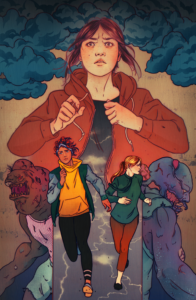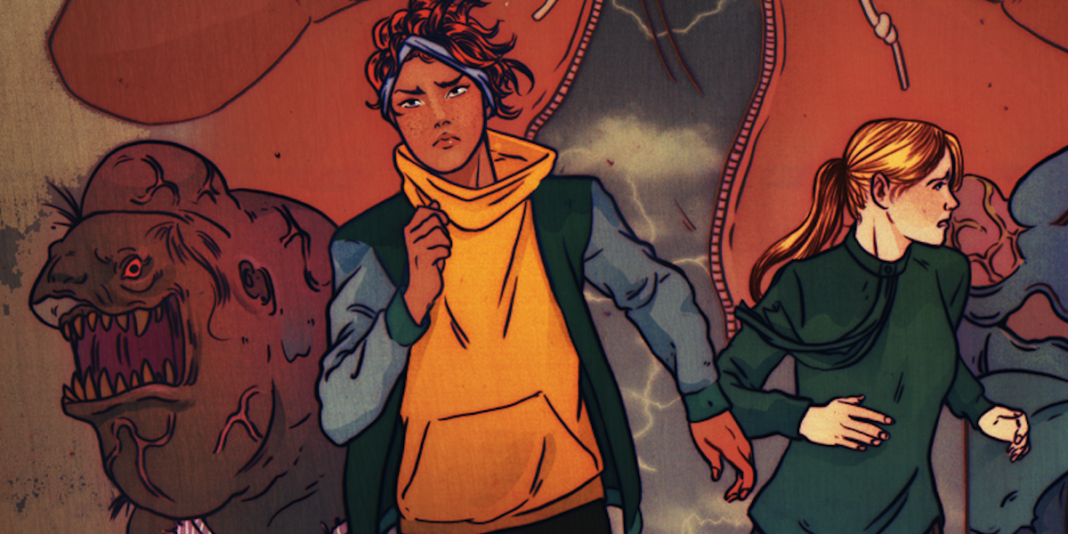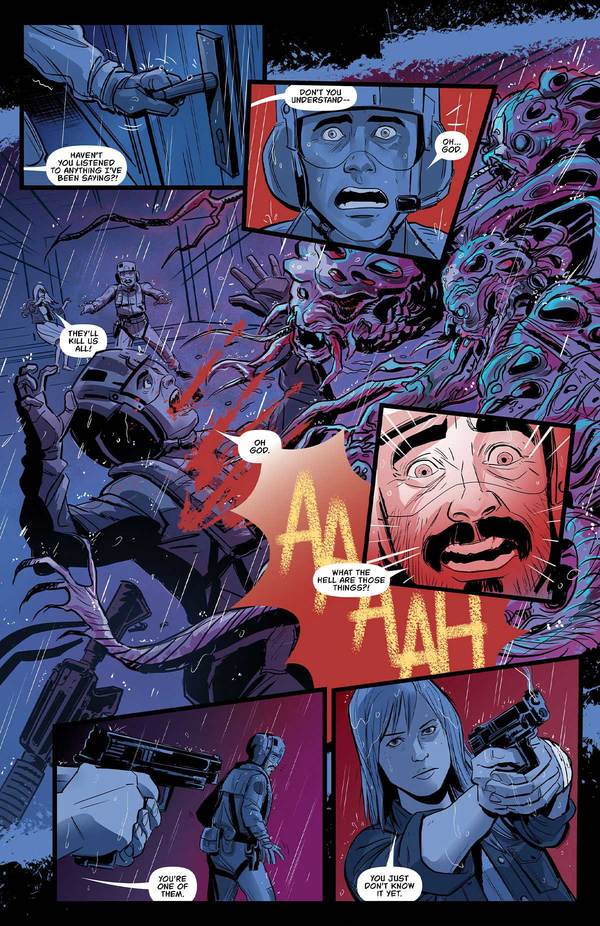
Eve of Exctinction
Written by Salvatore A Simeone and Steve Simeone
Full Color Art #1, Line Art #2-4 by Nik Virella
Line Art #5-6 by Issac Goodhart
Color Art #2-6 by Ruth Redmond
Lettering by Ariana Maher
Edited by Sebastian Girner
Cover art by Maria Nguyen
Published by TKO Studios
The premise of Eve of Extinction is that a virus brought inland by a hurricane causes those infected to become monsters, but the only people affected are cisgender men. It’s not a novel concept, and unfortunately, Eve of Extinction falls face-first into the well-worn pratfalls of the myriad similar stories to precede it.
First and foremost, the existence of transgender people is completely unacknowledged by the text. In a story that considers the idea of gender in the United States in 2019, this is an inexcusable oversight. Transgender people are at the center of a national conversation about gender, about whether or not we should retain the right to, say, employment protections based on our transgender status, or whether we should be allowed to use public restrooms. To build a world that is founded on gender and neglect to include transgender people is to make a statement of exclusion.
It’s hard to imagine this wasn’t a foreseeable problem, either. Even aside from the larger cultural conversation around gender currently underway in the United States, the topic has already been well covered in the world of comics. In 2018, Man-Eaters began a gender-based horror story that excluded key demographics, leading to a high profile kerfuffle on Twitter earlier this year. (Man-Eaters did eventually add a trans character, by the way.)
Adding transgender people to your narrative might make navigating the topic of a gendered pathogen more complicated, but to throw up your hands and simply decide to exclude an entire subset of the population simply because they complicate things was clearly the decision made here.
There are readily available solutions for those creators don’t feel personally equipped to represent a certain marginalized demographic. The television adaption of Y: The Last Man, another example of the “gendered pathogen” subgenre of comics, added a trans character to the cast and ensured there was relevant representation on the writing staff by hiring novelist Charlie Jane Anders, a transgender woman.
Another avenue to avoiding common pratfalls would be hiring a sensitivity reader who represents the demographic in question to read over the script and provide notes. A sensitivity reader can be an invaluable resource in navigating complicated issues successfully.
As Lilah Sturges told The Beat in July 2018, “If you’re writing a character who belongs to a specific marginalized community, it’s so important and useful to hire a sensitivity reader. As a member of that community, they can look over what you’re doing and make it feel more real, make it feel more fleshed out, and also point out any mistakes you’re making, so when your book comes out you don’t look like a complete idiot because you screwed something up a member of that community will immediately recognize.”
The decision to exclude trans people from the narrative of Eve of Extinction also invites the question: if engaging with complicated issues surrounding gender isn’t in your wheelhouse, then why tell a story about a gender-based pathogen? It’s a question that the text invites more than once. For one thing, the narrative would hardly be changed if it were a standard zombie story, where people of all genders were affected by the pathogen, and these women simply happened to be survivors together.
In Eve of Extinction, we are introduced to a few men before the rain turns them into physical grotesqueries, but they receive little development beyond being nominally introduced before the transformation occurs. Once they have been mutated, almost no space is devoted to examining the connection between what they have become and the humans they had been before; they have essentially just become monsters.
(It seems worth mentioning that the text does include a gay character. At the school dance, a student says that his boyfriend has been acting weird, to which another student replies, “Your boyfriend just is weird.”)
The design of the monsters is visually interesting, as they are strongly reminiscent of The Thing, rather than simply being zombified versions of the men. At one point, the survivors enter a zoo. Unfortunately, while this does lead to an encounter with an interesting-looking orangutan monster, it does drive home the fact that the text decided to consider how zoo animals would be affected by this infection before bothering to take transgender people into account.
The women and girls who serve as the protagonists of the book receive little character development themselves. Most are solely defined by their relation to men. In the pages that open issue #5, we jump between panels that show flashbacks to Christine’s prior life, interspersed with glimpses from her fight against the man-monsters. Her career playing sports is cut short by pregnancy and then later an injury, and her relationship with her daughter’s father is strained by her subsequent painkiller abuse. There’s a moment where the text almost manages to equate her past experiences and the violence she’s dealing out to the man-monsters in a meaningful way, but the comparison never quite manages to connect.
Another character, Abby, carries baggage from her experiences in Hurricane Katrina, but other than a few action-movie-style quips about how there “weren’t monsters trying to kill us” in New Orleans, the experience has little effect on her character. Abby’s arc concerns the competition between her cynicism and her idealism, and her younger sister Jane points out at one point that she has always said: “no one left behind.” While Abby’s arc concludes in a predictable fashion, elsewhere, the text suggests that it’s fine to leave a person behind if that person is transgender, given that trans people are left behind for the entirety of the narrative.
Although TKO Studios seems keen to push the limits of comic publishing and storytelling, with Eve of Extinction, the creative and editorial teams fall short. If you’re interested in picking up any of the publisher’s Wave 2 books, skip this one. It’s not worth the price.









Hey! I’m one of the writers for this book and I just wanted to say that these are all astute observations, and very real problems with the work we did, and something we’d like to correct in any future work that we do. It was largely my own total ignorance and privilege that led me to not consider these issues until we were writing Issue #4, and already had several issues worth of art back by the time I thought of it. I recognize this is a huge problem to begin with, but by then there were a bevy of people depending on us, and it was too late to do more than pay lip service, or hurt the people working on the book and the other books by delaying or pulling it. Still, I’m glad that people are pointing these problems out.
I just want to make clear that in saying this I’m not trying to provide an excuse or anything: it’s a total screw up and not excusable to have not considered it right out of the gate, I’m just trying to provide some insight into the way I messed up here, and I hope that’s helpful.
If we have a chance to do another work in this world I think, now that I know better and people have done some of the emotional labor of educating me about trans sensitivity readers and similar people in the space, that I would want to go a step further and speak with a few, and try to include at least one in the authorship part of the process, with a name on the book and everything. I think it’d be important for folks to see themselves represented not only in the story, but in the authorship of this kind of story as well. I really hope that if we get to revisit it that we have a chance to address the problems you’ve brought up here in a meaningful way that feels satisfying for the folks that I’ve hurt and done a disservice to with it.
Thanks for the critique, and for being honest and not pulling punches with it! This kind of thing is important, and I hope that all the authors of works you critique can try to use it as a way to learn and improve and cause less harm with the things they write!
Comments are closed.